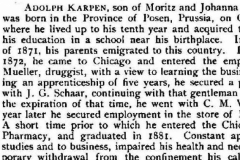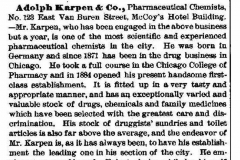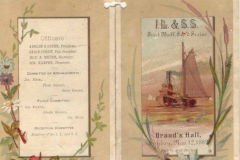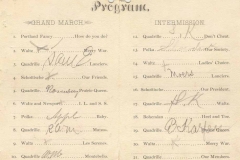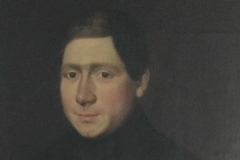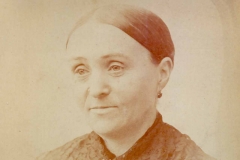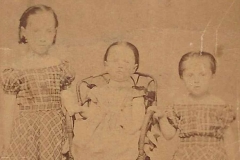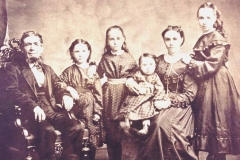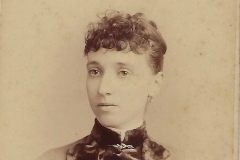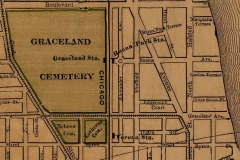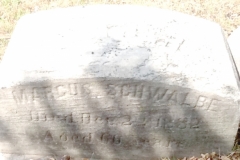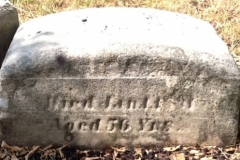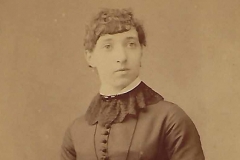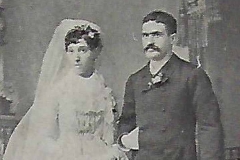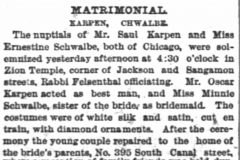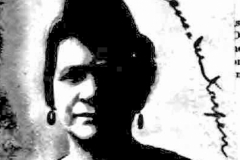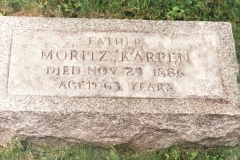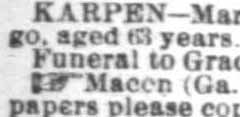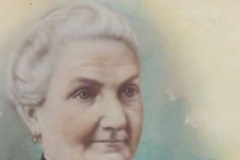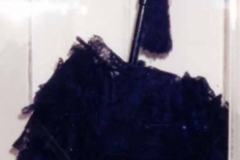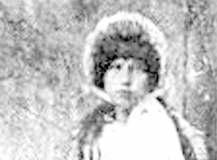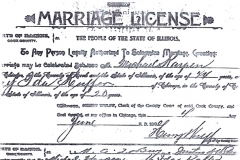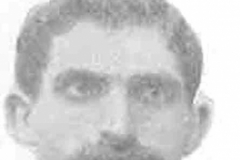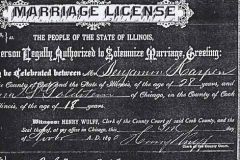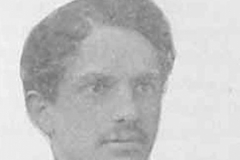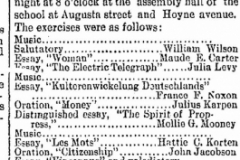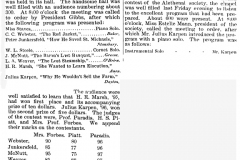The Karpen Family: 1880-1892
In this way we developed an organization knit closely by ties of blood and interest, and undoubtedly it was an important factor in our growth; curiously enough, we got along without quarrels! —Solomon Karpen in Neil Clark, “How Nine Brothers Built Up a $10,000,000 Business,” Forbes, August 1, 1926, 10.
The family in 1882 moved just a few blocks north of Emma Street (now Cortez Street) to 563 Noble Street,[1] the same building where Solomon and Oscar’s former employers, the Deimel family, had lived.[2] At age 58, Moritz was still working by himself as a carpenter[3] and cabinetmaker.[4]
Not all the Karpen brothers were involved in the business. Benjamin, in his mid-twenties, continued in the cigar retail and wholesale business. He had a store with Louis Miller, under the name Karpen & Miller at 140 Monroe Street.[5]
Early in 1885, Adolph, “having regained his health, determined to embark in the drug business again, but in an establishment of his own.”[6] The noted Chicago historian, Alfred Andreas, profiled Adolph in his History of Chicago, 1871-1885. Adolph’s selection at only age 25, an immigrant and recent graduate, showed that he had already reached, or showed the potential to attain, a certain echelon in the Chicago’s pharmaceutical business world. Andreas noted that Adolph was a member of the Chicago College of Pharmacy.[7] His pharmacy, Adolph Karpen & Co.,[8] was located at 123 Van Buren[9] and then at 280 Clark Street.[10] The Chicago Board of Trade’s 1885 volume included a very favorable profile of Adolph.[11]
The brothers made the passage from immigrants to American citizens. Adolph was naturalized on October 23, 1882, the first of the Karpen brothers to do so.[12] In fall 1884, Benjamin (October 17, 1884), Oscar (October 23, 1884), and Solomon (November 1, 1884) became naturalized citizens at the Superior Court, Cook County, Illinois.[13] Those, who were old enough, were registered to vote in 1888.
The Karpen young men were involved in the Jewish community in Chicago.[14] Adolph was a member of the Jewish fraternal organization B’nai B’rith. He was president of a new (and short-lived) Jewish group, the Ideal Literary & Social Society “I. L. & S. S” in 1881 and 1882; Solomon was the treasurer in 1882.
Solomon’s Next Step
After Solomon felt his business was on strong footing, it was time for him to think of starting a family. Not surprisingly, as the eldest brother he was the first to marry. It could have been that the Posen (and perhaps even the Wongrowitz) connection that brought Ernestine Schwalbe and Solomon together in 1881 in Chicago.
Ernestine Schwalbe, called “Tena” (and later “Tina”), was born in La Crosse, Wisconsin in 1862 and was brought up in a very modest household with strong ties to Judaism. Ernestine’s father Marcus Schwalbe was born in Prussia in 1816. He immigrated in the late 1850s and traveled to La Crosse via New Orleans. Family lore is that Marcus was brought over by the Cantrowitz family from Posen (perhaps Wongrowitz) to work in their clothing store in La Crosse. Her mother Henriette Bloch was born in 1838 in Baden in southwest Germany and immigrated ca. 1860 to join her future husband.
According to Ernestine, Marcus served as a lay rabbi and teacher for his small German-speaking reform congregation. The German-language minutes of the congregation indicated that he was indeed a teacher and gave several sermons on the High Holy Days; however, he was not a lay rabbi nor a congregational officer. Ernestine wrote that Marcus was one of the early members of the Jewish fraternal order, B’nai B’rith, Cremeix Lodge, that was formed in 1870 in La Crosse although no record of this membership has been found.
Marcus became ill with diabetes in 1877, and his eyesight deteriorated. At the same time, as was happening in other small Jewish communities, many families were beginning to leave La Crosse (population 14,500) for the big cities. The Schwalbe family moved to Chicago in 1880 where they lived at 395 S. Canal St. Ernestine worked as a clerk in a store in 1880 and her sister at 15 also worked. This was very unusual; they must have needed to support their family. Shortly after Ernestine met Solomon Karpen, her father passed away at age 66 on December 22, 1882. Marcus Schwalbe was laid to rest in the Hebrew Benevolent Society Cemetery (founded in 1851), north of the city center in Chicago; the cemetery was later called “Jewish Graceland.” He was the first of the Karpen-Schwalbe family to be buried in the family plot.
Solomon and Ernestine’s marriage was recorded on their marriage license on February 16, 1884. Salomon [sic] Karpen age 26. Ernestine Schwalbe age 21 were married by Rabbi B. Felsenthal (b. 1822 Kaiserslautern, Germany), rabbi of the “Zion Congregation,” West Chicago, [15] a Reform Synagogue. The couple’s marriage was reported in The Trade Bureau, under its “Chicago Reports,” in February 1884: “The marriage of Miss Tena Schwalbe and Mr. Sol. Karpen was solemnized Sunday afternoon at 4:30 at Zion Temple, corner of Sangamon and Jackson streets. Mr. Karpen is a member of the well known firm of Karpen Bros., manufacturers of parlor furniture.”[16] Their honeymoon was also mentioned: “Mr. Sol. Karpen has returned from a charming wedding tour, and settled down to making the same class of fine furniture as before.”[17] The family lived on 200 Oak Street and then Division Street, just a few blocks from Solomon’s parents’ home.
The family, however, was facing changes that never would have happened if they had still been living in Prussia. Several of the brothers took Christian women as their brides. Less than a year after Solomon’s wedding, Oscar, 25, married Mary Simons, who was 19. Mary was born Karen Marie Simonsen in Denmark and immigrated in 1868. She was a Protestant. They were not married by a rabbi, but by a justice of the peace in Chicago on December 20, 1884.[18]
In fall 1886 Adolph, 26, married Eugenia Wilhehmina Svennsson who was just 19. Eugenia “Jennie” was a Lutheran[19] who was born in Gothenberg, Sweden.[20] She immigrated in 1880 [21] and was said to be an opera singer. Again, it was not a Jewish wedding and a justice of the peace presided at the ceremony that was held outside of Chicago.[22] Adolph and Oscar moved from their parents’ home on Noble Street after their weddings, but again their new homes were not far away. Six sons were still living with Moritz and Johanna.
At the end of November, 1886, the patriarch of the Karpen family died. Moritz was 63 and was ill for only two weeks.[23] His obituary ran in two Chicago newspapers and the German-language Illinois paper.
Moritz was buried in the Karpen-Schwalbe family plot in the Hebrew Benevolent Society Cemetery, “Jewish Graceland” Cemetery, Chicago.
The Karpen extended family grew, but it still centered around the family home and the family matriarch, Johanna. After her husband’s death, Johanna remained in their home in the Northwest section of Chicago. After each of her sons married, the newlyweds moved to a home in the vicinity of the family home. As of 1892, the three youngest sons still lived with Johanna at 36 Potomac.[24]
In 1888 Isaac, “Ike,” at 23, married Hattie Bernstein who was 18. Hattie was born in Ohio[25] and grew up in Indianapolis, Indiana.[26] Her mother was born in Germany, [27] and immigrated in 1870.[28] Her father was an orphan.[29] They were married by the rabbi of the North Chicago Hebrew Congregation. [30]
Solomon and Ernestine moved their family to Orchard Street near Center Street. Oscar’s family lived on Elk Grove. In the tradition of Ashkenazic German Jews, Solomon’s daugher, Marie and Oscar’s son, Morris K., were most certainly named to honor the memory of their deceased paternal grandfather, Moritz. Marie could also have been named to honor her maternal grandfather, Marcus Schwalbe.
Two brothers took brides in 1890. Mike married Ida Kuffer, a Catholic from Chicago, when she was 20. A justice of the peace performed the ceremony.[31]
Benjamin, 28, married Tina D. Goldstein, when she was 18. The ceremony was performed by Rev. S. Bauer, rabbi of the Moses Montefiore Congregation in Chicago.[32]
Julius, the youngest—and the only native born— brother, however, took a very different path in his youth. In June 1892, he was a member of the first graduating class of Northwest Division High School at North Claremont and Potomac. Julius gave the oration entitled “Money” and received a $25 “cash prize.”
He attended the University of Illinois Class of ’96 for two years. He won second prize in the Adelphic Declamation Contest with a prize of $5 for his speech “Why He Wouldn’t Sell the Farm.” The family must have paid for piano lessons for him because his piano solos were part of at least two other declamation contest programs.
Julius transferred to the University of Chicago in the winter of 1893 where he took a course of literary studies.[33][34] “The Chicago club of the University of Chicago grants each year $250 scholarships to deserving boys and girls of Cook County who attain the highest average in a competitive examination. The first examination of the club, conducted by Principal Will J. Bartholf in July, awards the scholarships to Paul R. Chapman and Julius Karpen.”[35] Julius was member of the delegation of the local Republican Club that attended the National League of Republican Clubs’ annual meeting and was on the university’s debate team.
As young men they shared a love of fishing. Their vacations were reported in the furniture trade press and in the Chicago newspapers. They spent their free time in Wisconsin and Illinois fishing: Adolph is “expected to bring back a well assorted stock of fish stories.”[36] “The only covering [Sam] is buying now is in the way of blankets and mosquito netting.”[37] “We hear some very fishy stories about the catches Sam made while away. The biggest is that he brought home a fifty-seven pound muskalonge (a member of the pike family) as a present to his mother, and a trophy of his ability with the hook and line.”[38]
- Lakeside Directory of Chicago, 1882, 663. ↑
- Lakeside Directory of Chicago, 1876-7, 313. Lakeside Directory of Chicago, 1877-8, 306, 319. ↑
- Lakeside Directory of Chicago, 1881, 650. Lakeside Directory of Chicago, 1883, 672. and 1884 ↑Lakeside Directory of Chicago, 1882, 663. ↑
- Lakeside Directory of Chicago, 1887, 835. The Lakeside Directory of Chicago, 1887, 1764. ↑
- Alfred Andreas, History of Chicago, 1871-1885. Vol. 3. (Chicago: 1884), 550. ↑
- Alfred Andreas, History of Chicago, 1871-1885. Vol. 3. (Chicago: 1884), 550. ↑
- Lakeside Directory of Chicago, 1885, 747. ↑
- Lakeside Directory of Chicago, 1885, 747. ↑
- Lakeside Directory of Chicago, 1886, 1721. ↑
- Origin, Growth, and Usefulness of the Chicago Board of Trade: Its Leading Members (New York: Historical Publishing Co., 1885-6), 314. ↑
- National Archives and Records Administration (NARA); Washington, D.C.; Soundex Index to Naturalization Petitions for the United States District and Circuit Courts, Northern District of Illinois and Immigration and Naturalization Service District 9, 1840-1950 (M1285); Microfilm Serial: M1285; Microfilm Roll: 104. ↑
- National Archives and Records Administration (NARA); Washington, D.C.; Soundex Index to Naturalization Petitions for the United States District and Circuit Courts, Northern District of Illinois and Immigration and Naturalization Service District 9, 1840-1950 (M1285); Microfilm Serial: M1285; Microfilm Roll: 104. ↑
- “The City in Brief,” The Daily Inter-Ocean (Chicago), Dec. 19, 1881. ↑
- Marriage License, LDS Film #: 1030137, Feb 16, 1884. Salomon age 26. Ernestine age 21. Rabbi B. Felsenthal, Rabbi of the “Zion Congregation” Chicago. ↑
- Trade Bureau, Feb. 23, 1884, 36. ↑
- Trade Bureau, Mar. 15, 1884, 36. ↑
- “Illinois, Cook County Marriages, 1871–1920.” Index. FamilySearch, Salt Lake City, Utah, 2010. Illinois Department of Public Health records. “Marriage Records, 1871–present.” Division of Vital Records, Springfield, Illinois. ↑
- “Karpen,” Chicago History Museum Biographical Notes File. ↑
- US Census 1910. ↑
- US Census 1910. ↑
- Illinois State Marriage Records. Online index. Illinois State Public Record Offices.
- Certificate of Death, State of Illinois, Cook County No. 94254. ↑
- Registered Voter List, Chicago, 1892, 595. ↑
- US Census 1910. ↑
- Isaac Karpen: LDS Film #: 1030170. Marriage License dated Jan 21, 1888. ↑
- US Census 1910. ↑
- US Census 1910. ↑
- Charlotte Westal, granddaughter of Isaac Karpen. Interview with Emily C. Rose.↑
- Isaac Karpen: LDS Film #: 1030170. Marriage License dated Jan 21, 1888. ↑
- Michael Karpen and Ida Kuffer: Illinois Marriage License; # 153480; Illinois State Marriage Index; LDS Film #1030191. ↑
- Benjamin Karpen and Tina Goldstein, Marriage License # 159799, 1890. ↑
- John Leonard, ed., Book of Chicagoans: A Biographical Dictionary of Leading Living Men of the City of Chicago, (Chicago: Marquis & Co., 1905), 322-3. ↑
- “Julius Karpen Obituary,” Grand Rapids Furniture Record, April 1907, 627. “Once an Illinois Man: Former University Student Killed by Fall,” Urbana Courier Herald, April 2, 1907.↑
- Chicago Daily Tribune, Aug. 17, 1892. The Illini (University of Illinois Student Newspaper), Dec. 13, 1892; May 23, 1893; Sept. 20, 1893. ↑
- American Cabinet Maker and Upholsterer, July 13, 1889, 10. ↑
- American Cabinet Maker and Upholsterer, Aug. 3, 1889, 10. ↑
- American Cabinet Maker & Upholsterer, Aug. 20, 1892, 13. ↑

